갤러리진선, 〈각자의 기호 Marks of Identity〉, 2024. 11. 01–11. 22
전통을 딛고 미래로 향하는 예술
이주희 미술평론가
최근까지 갤러리진선은 ‘전통’과 ‘현재’ 그리고 ‘새로운 해석’이라고 특징지을 수 있는 전시들을 다수 선보였다. 그 예로 ‘전통’의 매체를 활용해 현재의 감각을 표현하는 회화·동양화· 조각 작품들을 선보였고 빠르게 다변하는 시대의 흐름 속에서도 차분히 자신만의 조형언어를 구축해 가는 작가들의 전시를 선보였다. 전시로서 ‘전통’에 주목한다는 것에도 다양한 파악이 있을 수 있겠으나 갤러리의 기획전시가 다양한 층위의 이들에게 전통과 문화예술에 대한 또 하나의 스킨쉽 포인트가 될 수 있다는 점과 전시라는 지성적 기획 행위가 이 시대를 직간접적으로 기록할 또 하나의 주관을 제시하고 있다는 점에는 큰 무리 없이 공감대를 형성할 수 있을 것이다.
이번 전시 역시 동시대의 현안에 대한 갤러리진선의 주목이 돋보인다. 〈각자의 기호 Marks of Identity〉라 이름지어진 이번 전시에는 항백·유승호·황규민 작가의 연구가 담긴 작품 30여점을 선보인다. 60 · 50 · 30대의 연령 분포를 보이는 3명의 작가는 서예·회화·동양화로 각기 다른 전문 분야를 지녔지만 우리가 ‘전통’이라고 부를 수 있는 개념·시공간·문화양상 등을 현시대의 예술로 환원하고 있다는 동질성을 지닌다. 서예가(書藝家)이자 서법(書法) 연구가인 항백(박덕준)은 서예가 지닌 풍부한 미학의 현대적 환원으로 기백 넘치는 작품을 선보이고 있으며 유승호는 인간의 인지 체계에 끊임없이 도전해 온 미술과 한민족의 언어로서 진화를 거듭해 온 한글을 접목해 가볍고도 단단한 회화를 보여주고 있다. 마지막으로 황규민은 동아시아 지성의 역사라고도 할 수 있는 ‘동양화’의 전통을 근간으로 하는데 동양화의 여러 뿌리들 중에 자신에게 유효한 근거들을 발견해 ‘화보’의 형식으로 제시한다.
동시대 예술가들의 전통을 위시한 이같은 현대적 기록은 향후 우리가 새롭게 정립해 나가야 할 인문·예술의 방향 설정에 큰 좌표가 될 수 있을 것이다. 나아가 다층적인 가치를 수용하는 현대인의 심미적 취미활동에도 다양성을 부여할 것이다. 〈각자의 기호〉전 참여작가 항백(박덕준)은 서예가 “이 시대의 새로운 서예”로 거듭나길 바란다. 또한 그는 이를 위한 방법으로 “서예가 현대미술의 일부”가 되어야 한다고 말한다. 지난 시간 미술은 비례·균형·조화 같은 인간의 미감에 끊임없이 호소하며 자신의 저변을 굳건히 지켜왔고 현대미술 역시 미술의 연장에서 확장과 부정, 생성 등의 다양한 움직임으로 존재의 당위성을 확보해 왔다. 그리고 이러한 양상은 서예 역시 다르지 않은데 항백은 전통에 대한 수용과 새로운 해석의 최일선에서 ‘고전미의 현대화’, ‘고대 문자 연구’, ‘문자도’라는 세 가지 관점으로 연구와 창작을 이어가고 있다.
회화의 영역에서도 과거로부터 전승되어 온 유산들을 선택 학습하는 것이 가능하고 이것을 근간으로 개인의 고유한 정체성(Identity)과 상징(Marks)에 대한 ‘창의(創意)’를 갖는 것이 가능하다. 유승호 작가의 작업은 그림이라는 시각적 효과에 대한 인간의 직관과 더불어 한민족의 한글에 대한 수용 원리를 유미적으로 넘나든다. 작가의 화면에서 가장 먼저 느껴지는 것은 편안하고 자연스러운 느낌의 형상이지만 화면으로 파고들수록 드러나는 깨알 같은 글씨들로 인해 가벼운 것들로 쌓아 올린 깊고도 구축적인 화면을 만날 수 있다. 또한 깨알같은 글씨의 출처가 유아적 문구와 더불어 서브컬처의 의성어·의태어인 것을 참고한다면 유승호의 화면이 다문화적 출처를 지닌, 깊지만 경쾌한 전통적 요소들로 이루어진 회화임을 느낄 수 있다.
이번 〈각자의 기호〉전에 참여한 항백·유승호·황규민 작가가 보여주는 동질성의 연장에서 우리는 3인 작가의 작업이 여전히 평면과 지필(紙筆)을 중심으로 하면서도 평면 내에 머무는 것이 아니라 다양한 개념적 변주를 시도하고 있음을 알 수 있다. 이중 황규민의 작업은 상황과 창의의 모사에서 나아가 내면을 탐구하여 발견되는 정신·문화적 소산(所産)들이 현존할 수 있는 무대로써 자신의 화면을 이용하고 있다. 화보(畫譜)는 동양고대문명의 은상(殷商, BC.1600-1046경) 시대 갑골문자까지 거슬러 올라갈 수 있을 정도로 지난한 시간을 지닌 매체이다. 화보의 주된 역할은 취사선택된 미감과 그 내부의 형식 나아가 시대의 미학을 전하는 것이었을 텐데 황규민은 현재의 시점에서 과거와 현재를 적극적으로 참조해 새로운 미감을 개발하고 화보의 형식으로 선보인다. 황규민의 작업으로 인해 관람객은 전통을 참조한 또 하나의 전통이 형성되는 과정을 목격할 수 있게 된다.
이번〈각자의 기호 Marks of Identity〉전에서는 ‘전통’에 대한 해석과 동시대적 ‘창의’를 발휘하고 있는 3명 작가들의 작품을 한곳에서 살펴볼 수 있다. 이로써 작가들이 딛고 있었던 전통의 자리와 그들이 발휘하고자 했던 창의의 성격을 가늠해 보고자 한다. 동서양을 막론하고 인간의 시지각적 감각을 화면으로 옮기는 방법들이 발명되었고 그 방법들이 심화되어 갈수록 시지각적 감각을 너머 다감각적 영역의 것들을 화면에 담고 향유하는 방법들이 더욱 중요한 것으로 대두하기 시작했다. 갤러리진선에서 개최되는 이번 〈각자의 기호〉전에 출품된 작품들 역시 시지각적인 ‘전통’을 추구하는 것에 머물러 있는 것이 아니라 미래로 전해질 새로운 전통과 정신적 가치를 발견하기 위한 질문을 이어가는 작품들이다. 관람객 역시 이시대 예술가들의 진중한 물음이 담긴 작품을 감상하고 보이는 것을 넘어선 저마다의 가치를 찾길 바란다.
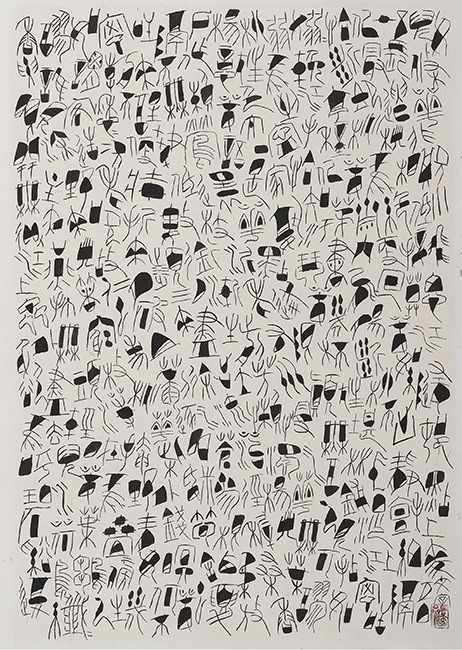
항백, 미래로 간 문자, 한지에 송연먹, 66x95cm, 2024
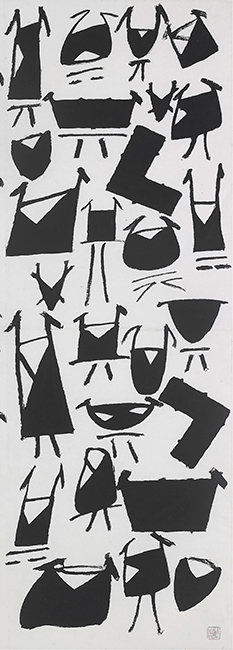
항백, 청동기시대, 한지에 송연먹, 153x53cm, 2024
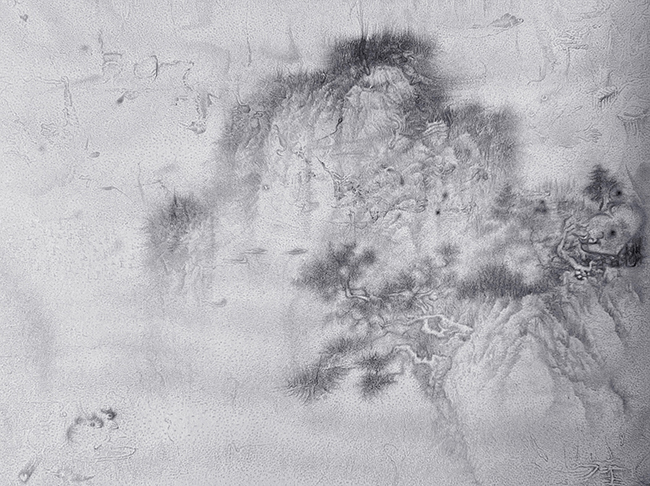
유승호, 가나다라ganadara, 종이에 잉크, 122x160cm, 2019
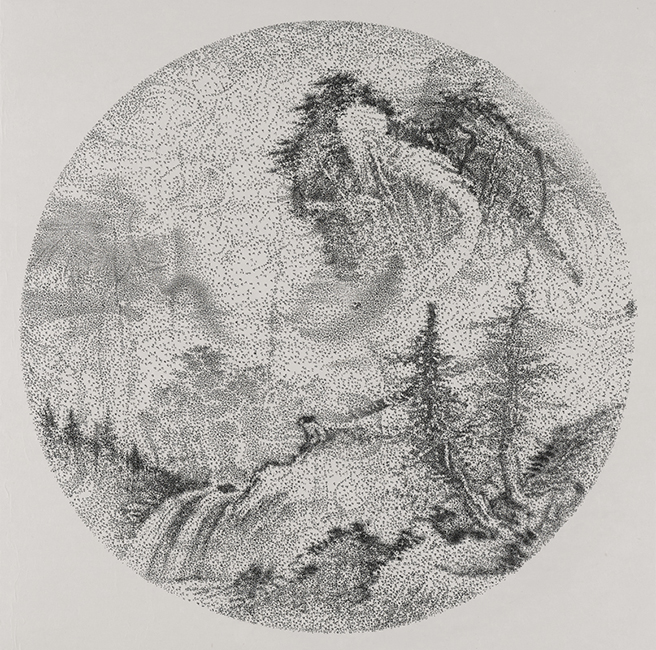
유승호, 청산에살어리랏다 Yodeleheeyoo~, 종이에 잉크, 72.7x72.7cm, 2016
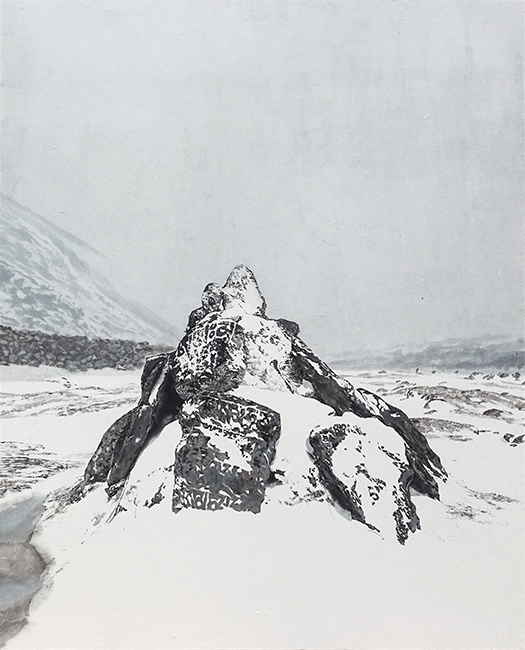
황규민, Beyond the Stone, 한지에 수묵, 162.2×130.3cm, 2019

황규민, 화보14-Beyond the Stone, 한지에 목판, 혼합재료, 155.5×126.6cm, 2022
Art that is built with traditions and heads toward the future
Lee Juhee, Art Critic
Until recently, Gallery Jinsun has held many exhibitions that can be characterized as “tradition,” “present,” and “new interpretations.” For example, the gallery has introduced paintings, oriental paintings, and sculptures that express senses of the present using “traditions” as media. Also, it has held exhibitions of artists who have been building their own formative languages despite the rapidly changing trends of the times. While there may exist various interpretations of focusing on “tradition” in exhibitions, the fact that the gallery's special exhibition can be another point of contact with tradition, culture, and arts for people from different backgrounds and the intellectual activity of planning exhibitions suggest another subject that will directly or indirectly record this era will be able to form a consensus among the audience without much difficulty.
This exhibition also stands out due to Gallery Jinsun’s attention to contemporary issues. The exhibition, titled “Marks of Identity,” presents about 30 works containing research done by artists Hang Bak, Yoo Seungho, and Hwang Kyumin. While the three artists, with an age distribution in the 60s, 50s, and 30s, have different areas of expertise in calligraphy, painting, and oriental painting, they share the similarity that they all convert the concepts, time, space, and cultural aspects that we can call “tradition” into contemporary art. Hang Bak (Park DukJoon), who is a calligrapher and calligraphy researcher, presents works full of spirits by modernizing the rich aesthetics of calligraphy, and Yoo Seungho combines art that has constantly challenged the human cognitive system with the ever-evolving Hangul, which is the language of the Korean people, creating light, yet solid paintings. Lastly, Hwang Kyumin’s works are based on the tradition of “oriental painting,” which is the history of East Asian intellects. He finds valid evidence among the various roots of oriental painting for his works and presents them in the form of a “pictorial.’
These modern records in which contemporary artists value the traditions can serve as great coordinates for setting the direction of humanities and arts that we must newly establish in the future. Furthermore, it will provide diversity to the aesthetic hobbies of modern people who accept multi-layered values. Hang Bak (Park DukJoon), participating in the exhibition “Marks of Identity,” hopes calligraphy to be reborn as “a new calligraphy of the modern era.” He also says that as a way to achieve this, “calligraphy should become part of modern art.” In the past, art has firmly maintained its foundation by constantly appealing to human aesthetic senses such as proportion, balance, and harmony, and modern art has also secured its existence through various movements such as expansion, negation, and creation as an extension of art. This aspect is no different in calligraphy and Hang Bak is taking the lead for acceptance and new interpretations of tradition and continues to perform research and creation from the three perspectives: “modernization of classical beauty,” “research on ancient characters,” and “character paintings.”
Even in the field of painting, it is possible to select and learn about legacies handed down from the past and to acquire “creativity” for an individual’s unique identity and symbols based on such. Artist Yoo Seungho's work aesthetically crosses human intuition about the visual effects of paintings as well as Korean people's principles of acceptance for Hangul. The first thing the audience can perceive from the artist's screen is a comfortable and natural feeling, but as you dive deeper into the screen, you can see a deep and structured screen made up of light objects which are fine writings. Also, if we consider that the source of the tiny writings is childish phrases as well as subculture's onomatopoeia and mimetic words, we can realize that Yoo Seungho's paintings are made up of deep but cheerful traditional elements with multicultural sources.
In the extension of the homogeneity shown by the artists Hang Bak, Yoo Seungho, and Hwang Kyumin who are participating in “Marks of Identity,” we can see that the works of the three artists focus on the flat surface and paper and brush; however, they also do not remain within the flat surface, but rather explore variations with different concepts. Among them, Hwang Kyumin's works go beyond copying situations and creativity and use the screen as a stage where spiritual and cultural products are discovered through inner exploration and can exist. A pictorial (畫譜) is a medium with a long history that can be traced back to the oracle bone script of the Shang Dynasty (c. 1600-1046 BC) of the ancient Eastern civilization. While the key role of the pictorial would have been to convey the selected aesthetic sense and its internal form, as well as the aesthetics of the era, Hwang Kyumin actively refers to the past and present from the present point of view to develop a new aesthetic sense and present it in the form of the pictorial. Hwang Kyumin's works allow the audience to witness the process of forming another tradition that references tradition.
In “Marks of Identity,” you can see the works of the three artists who interpret “traditions” and demonstrate contemporary “creativity” in one place. With this opportunity, we would like to gauge the position of traditions that the writers have been standing on and the nature of the creativity that they sought to demonstrate. Regardless of the East or West, the methods of transferring human visual and perceptual senses to the screen were invented, and as the methods became more advanced, the techniques of capturing and enjoying things in the multisensory realm beyond the visual and perceptual senses in the screen began to emerge as more important. The works exhibited in “Marks of Identity” at Gallery Jinsun are also the art pieces that do not remain in the pursuit of visual and perceptual “traditions” but continue to ask questions to discover new traditions and spiritual values that will be passed down to the future generations. We hope that the audience will be able to appreciate the works that ask fundamental questions of the contemporary artists and find your own values beyond what is visible to us.








